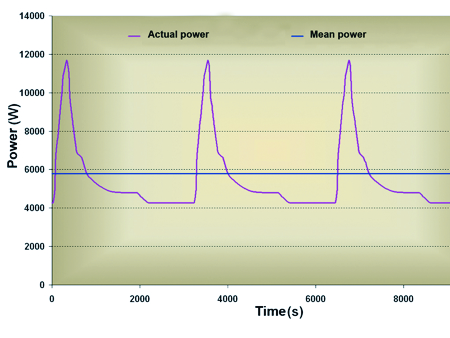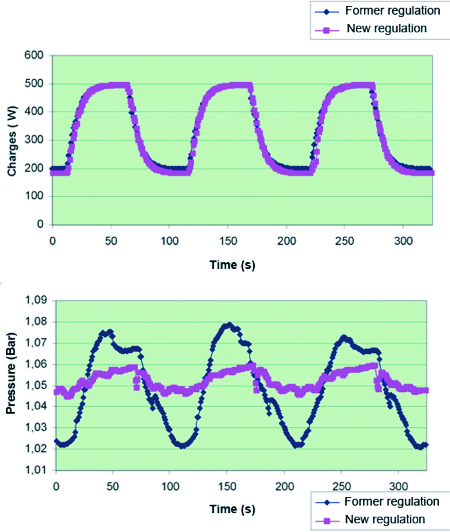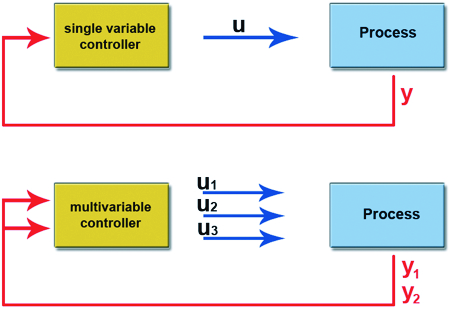On current research facilities dedicated to magnetic fusion, such as Tore-Supra and JET, cryogenic refrigerators are designed for operation in a quasi-stationary regime. They are therefore adapted to stable or slightly variable thermal loads. Traditional regulations are sufficient since they work around the nominal operating point. Refrigerators of future fusion reactors like ITER and JT-60SA (Japanese tokamak whose cryogenic system CEA is in charge) will operate under pulsed, high loads, which disturbs the whole process because of changes in pressure and temperature.
The magnetic system for confining the plasma is composed of superconducting magnets cooled to low temperatures. Currently, one knows how to confine the plasma for only a limited time. For JT-60SA, the so-called reference scenario is to burn for 100s, in a 3000s cycle repeated to infinity (Figure 1). These pulses create large variations in thermal loads on the magnets. The cryogenic system must be able to keep the magnets cold despite these pulsed loads. The refrigeration system for JT-60SA is designed for a 6 kW load. The power peaks are expected up to 12 kW. A cryogenic refrigerator must be capable of supporting twice the power of the nominal operation. Faced with these disturbances, the control command is not sufficiently effective.

Figure 1: Pulsed loads of a JT-60SA tokamak
Improvement, which is of major interest to the cryogenic community, is at the heart of a research project initiated by the SBT with Gipsa-Lab (CNRS, INP Grenoble and U. Stendhal) and Air Liquide. We have developed a new control strategy on the compression zone of the refrigerator. The objective is to regulate the high and low pressures of the system as close as possible to their reference values, respectively 1.05 and 16 bars. Our new controller is "multivariable": it takes into account the coupling between the pressures (see inset). This new controller has been implemented on the programmable logic of our facilty. It greatly improves the behavior of the refrigerator in the presence of varying loads. Indeed, fluctuations in low pressure (BP) and high (HP) of the refrigerator were divided by four, compared to the original control system (Figure 2).

Figure 2: Improved regulation of pressure by the use of a multivariable controller. For a variable load represented by the profile in (a), the controller acts on multiple flows through the valves (u1, u2, u3, ...) according to the values of high and low pressures (y1, y2) . The gain on each of them (low-pressure (b), high pressure not shown) is a factor of 4.
 Mono vs. Multi
Mono vs. Multi
On large industrial processes, we very often encounter PID (Proportional Integral Derivative). This control, easily implemented, is monovariable: A measure y (pressure, temperature, flow, etc.. ...) is controlled by an actuator u (valve, heating, etc ....). However, when measurements of the process depend on each other, it is wise to control the system in a multivariable way. The controller acts on multiple actuators based on several measures.
Figure: The 400W@1.8K facility
The SBT test facility is a dedicated machine to produce "cold". Its cooling capacity is 400 W at 1.8 K or 800 W at 4.5 K, which places it among the "large cold powers" now available for research. It welcomes studies of fundamental physics in the field of thermal hydraulics and turbulence, and technological studies for fusion (eg., tests on cold components). In 2007, a flow of about 700 g/s liquid helium at the temperature of 1.9 K was obtained, establishing a world record. So far, it was adapted to work with a constant refrigeration power. Let us recall that a cryogenic refrigerator cools a gas (helium) to its liquefaction temperature (4.2 K at 1 bar), through a compression-expansion cycle.